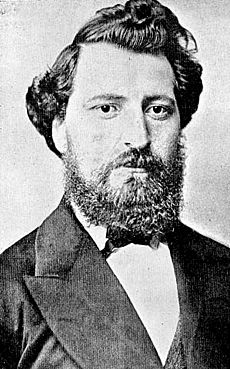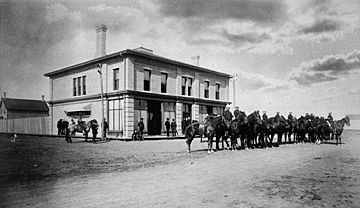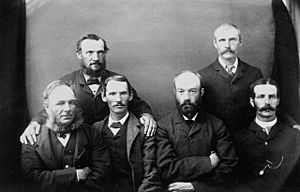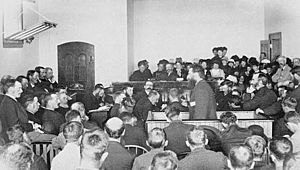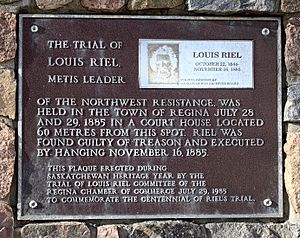Trial of Louis Riel facts for kids
The trial of Louis Riel happened in Regina, Canada in 1885. Louis Riel was a leader of the Métis and First Nations people in western Canada. They were resisting the Government of Canada in what is now Saskatchewan. This resistance was called the North-West Rebellion. The Canadian army stopped the rebellion, and Riel gave himself up. He was then put on trial for treason, a very serious crime against the government. The trial took place in July 1885 and lasted five days. Riel was found guilty and was later executed by hanging. This event had a lasting impact on how Anglophone Canadians and French Canadians felt about each other.
Contents
The North-West Rebellion
The North-West Rebellion happened in the winter and spring of 1885. Louis Riel, a Métis from Red River (now in Manitoba), had also led the Red River Rebellion in 1870. During that rebellion, a man named Thomas Scott, who was against Riel's temporary government, was executed. This was a very controversial event.
After the Red River Rebellion, Manitoba was created. However, many Métis in Manitoba felt pushed aside as more Canadian settlers moved into the new province. Many of them moved to the North-West Territories, settling near the South Saskatchewan River.
Riel himself had been living in Montana since 1875. In the spring of 1884, a group of four Métis, led by Gabriel Dumont, went to Montana. They asked Riel to come back to the North-West to help the Métis, First Nations, and other settlers. These groups had complaints for the Canadian government, such as needing secure land ownership and more democratic ways to govern the territories. Riel returned to Canada and became a main leader for the Métis and other groups in the North-West.
After talks with government representatives failed, the Métis and some First Nations took up arms in March 1885. The Canadian government sent soldiers west. This led to a major battle at Batoche, where the Métis forces were defeated in mid-May. After the defeat, Riel surrendered to the government on May 15, 1885. He was taken to Regina, the capital of the North-West Territories, and put in prison to await his trial. He was held with a ball and chain.
Riel's Trial
Facing Serious Charges
Riel was accused of six counts of high treason. This charge was made under an old English law called the Treason Act 1351, which was used in Canada before its own criminal laws were created in 1892. This old law meant that if Riel was found guilty, he would automatically be sentenced to death. Riel was the only person from the Rebellion charged with high treason. Many others faced less serious charges.
Lawyers for Both Sides
The government had a team of skilled lawyers, including George Burbidge and Christopher Robinson. They were experienced in representing the Canadian government. There were also younger lawyers who later became very successful.
Riel could not afford lawyers himself. His defence was paid for by supporters in Quebec. His main defence lawyer was Charles Fitzpatrick, who later became a very important judge in Canada. Other lawyers from Quebec also joined his defence team.
Courtroom Challenges
The trial started in Regina on July 20, 1885. It was held in a land company building, not a regular courthouse. The judge was Hugh Richardson, who was a local magistrate, not a higher court judge. Also, the jury had only six men, instead of the usual twelve.
Riel's lawyers immediately argued that the court did not have the right to try him this way. They said the trial should be before a higher court judge, with a twelve-man jury. Judge Richardson disagreed and said the court had the right to proceed. Riel then pleaded not guilty. His lawyers asked for more time to find witnesses, which was granted. The trial officially began on July 28, 1885, with the selection of the jury.
Choosing the Jury
Out of 36 people called for jury duty, only one spoke French, but he couldn't come. The only Catholic person was removed by the prosecution. So, even though there were French-Canadian and Métis people in the area, Riel was tried by a jury of six English-speaking Protestants.
The jurors were Francis Cosgrave (the foreman), Edwin J. Brooks, Henry J. Painter, Walter Merryfield, Peel Deane, and Edwin Eratt.
Riel's State of Mind
A big question during Riel's trial was his mental health. He had been in mental hospitals in Quebec twice before. During the Rebellion, he often mixed his political speeches with religious ideas. For example, he suggested that the Métis were a special chosen people. Some of his writings seemed to show signs of believing he was more important than he was.
This issue was tricky for both the prosecution and the defence. The law had a rule that someone could be found "not guilty by reason of insanity" if they couldn't understand their actions due to a mental health problem. The prosecution had to argue that Riel was not that unwell.
For the defence, Riel and his lawyers disagreed. His lawyers wanted to argue that Riel was not guilty because of his mental state. But Riel did not agree that he had mental health issues. He believed his actions were right and that he was not guilty. This disagreement about his mental state affected the whole trial.
The Prosecution's Case
The prosecution argued that Riel was the leader of the Rebellion and therefore guilty of high treason. They focused on Riel's leadership role. They also tried to stop the defence from bringing up the complaints that people in the North-West had against the government. The prosecutors also brought in doctors to say that Riel was not insane. The defence tried to show Riel's mental instability when questioning these doctors.
Riel often spoke up during the trial, saying he was sane and that the government was "irresponsible." He even asked to question some of the prosecution's witnesses himself, saying his lawyers didn't know enough about the local situation. But his lawyers wouldn't let him.
The prosecution called nine witnesses, including General Frederick Dobson Middleton, who led the Canadian army that stopped the Rebellion.
The Defence's Case
The defence presented their case on July 30. They called five witnesses, including doctors from mental hospitals and priests. These witnesses gave evidence about Riel's mental state, but they were not always supportive of him. Riel himself continued to oppose the defence's argument that he was insane. The defence's case lasted only one day.
Final Arguments
After the witnesses, both sides gave their final arguments. Riel's lead defence lawyer, Fitzpatrick, gave a powerful speech. He talked about the history of the Métis and their problems with the government, showing Riel as a leader who tried to help them. He also strongly argued that Riel's actions showed he was not sane. Many thought his speech had a big impact on the jury.
The judge then asked Riel if he wanted to speak to the jury. Riel said yes. His lawyers told the judge that Riel had the right to speak, but they would not be responsible for what he said.
Riel then gave a long speech. He defended his actions and spoke about the rights of the Métis people. He rejected his lawyers' idea that he was not guilty due to insanity, saying: "Life, without the dignity of an intelligent being, is not worth having."
Riel explained his use of religious ideas but insisted his political actions were practical. He criticized the Canadian government for ignoring the people and interests of the West. He hoped to be seen as a force for good in Canada one day. One historian noted that Riel's speech proved his sanity, but it also likely ensured he would be hanged.
The prosecution's closing argument was short. The lawyer, Robinson, pointed out that the defence and Riel were saying two different things: either Riel was a hero or he was insane, but he couldn't be both. He also questioned how Riel could have led people for 18 months if he was truly insane.
The judge then explained the facts and the law to the jury, including the rules for considering insanity.
The Verdict
On August 1, after thinking for about an hour and twenty minutes, the jury found Riel guilty of treason. However, they recommended mercy, meaning they wanted him to be spared the death penalty. The jury foreman was crying. Despite the recommendation, Judge Richardson had to sentence Riel to death, as it was the only punishment allowed by the Treason Act.
Riel then gave a second speech to the jury. He expressed satisfaction that he was not found insane and spoke about the concerns of the Métis. He also shared his ideas for developing the North-West, showing his strong leadership skills.
Appeals and Clemency
Legal Appeals
Riel's lawyers appealed the guilty verdict to higher courts. First, they appealed to the Court of Queen's Bench for Manitoba, which turned down the appeal. Then, they asked the highest court in the British Empire at the time, the Judicial Committee of the Privy Council in Britain, for permission to appeal. This was also denied.
Political Appeals
Many people also asked the Canadian government to show mercy and change Riel's sentence. Prime Minister Macdonald received many letters and petitions, especially from sympathetic French Canadians in Quebec. They felt that Riel, a French Catholic, was being unfairly treated by English Protestants. However, Macdonald refused to change the sentence, saying Riel would hang "though every dog in Quebec shall bark in his favour."
Execution
Louis Riel was executed by hanging on November 16, 1885. This happened at what is now the RCMP training academy in Regina.
One juror later said, "We tried Riel for treason, and he was hanged for the murder of Scott."
Criticisms of the Trial
Some people believe the trial was unfair. They point to the government's actions and the disagreements between Riel and his lawyers. Riel's lawyers often ignored his advice and refused his requests, like letting him question witnesses himself. Riel believed that if the witnesses had been properly questioned, it would have shown that his men were attacked first.
Historians have looked at criticisms about the treason charges. They generally agree that the charge of treason was legally correct for Riel's actions. They also say that his U.S. citizenship didn't matter because he was still considered a British subject.
Some lasting concerns about the trial include:
- The very old English law used to convict and execute Riel.
- How Riel's own lawyers treated him and their mistakes.
- Letters from the Justice Minister that suggest political interference in the trial.
- How Prime Minister Macdonald ignored the jury's recommendation for mercy.
- Macdonald's attempts to control the medical reports about Riel's mental state before his execution.
Some argue that Riel's powerful speech, where he denied being insane, was actually the strongest proof that he might have been.
Legacy
The Trial of Louis Riel is a play written by John Coulter in 1967. It is based on the actual trial records and has been performed every summer in Regina since then. It is North America's longest-running historical play.
In 2008, a minister in Saskatchewan said that the 125th anniversary of the 1885 Rebellion in 2010 was a great chance to tell the story of the prairie Métis and First Nations people. Their struggle against government forces helped shape Canada today.
More than 135 years after his trial, Riel is still one of the most popular and written-about figures in Canadian history. His trial continues to be a topic of discussion with different viewpoints and symbols.


